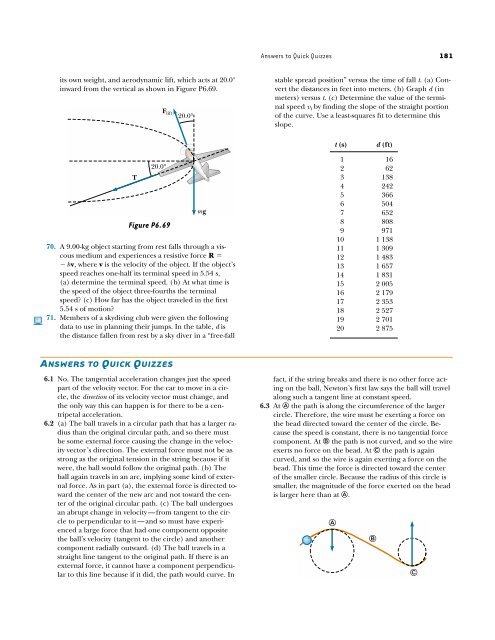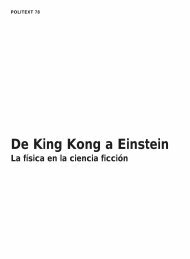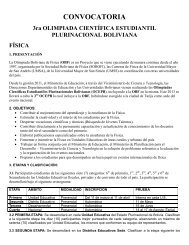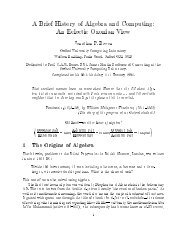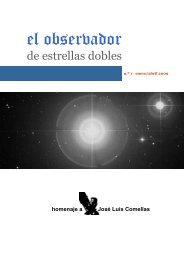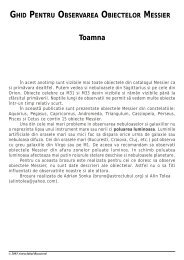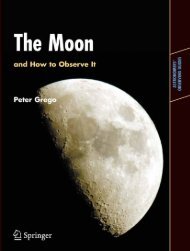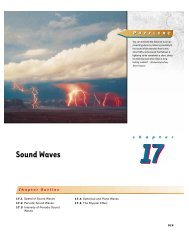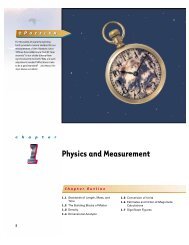Circular Motion and Other Applications of Newton's Laws
Circular Motion and Other Applications of Newton's Laws
Circular Motion and Other Applications of Newton's Laws
You also want an ePaper? Increase the reach of your titles
YUMPU automatically turns print PDFs into web optimized ePapers that Google loves.
its own weight, <strong>and</strong> aerodynamic lift, which acts at 20.0°<br />
inward from the vertical as shown in Figure P6.69.<br />
T<br />
20.0°<br />
F lift<br />
Figure P6.69<br />
20.0°<br />
70. A 9.00-kg object starting from rest falls through a viscous<br />
medium <strong>and</strong> experiences a resistive force R �<br />
� bv, where v is the velocity <strong>of</strong> the object. If the object’s<br />
speed reaches one-half its terminal speed in 5.54 s,<br />
(a) determine the terminal speed. (b) At what time is<br />
the speed <strong>of</strong> the object three-fourths the terminal<br />
speed? (c) How far has the object traveled in the first<br />
5.54 s <strong>of</strong> motion?<br />
71. Members <strong>of</strong> a skydiving club were given the following<br />
data to use in planning their jumps. In the table, d is<br />
the distance fallen from rest by a sky diver in a “free-fall<br />
ANSWERS TO QUICK QUIZZES<br />
6.1 No. The tangential acceleration changes just the speed<br />
part <strong>of</strong> the velocity vector. For the car to move in a circle,<br />
the direction <strong>of</strong> its velocity vector must change, <strong>and</strong><br />
the only way this can happen is for there to be a centripetal<br />
acceleration.<br />
6.2 (a) The ball travels in a circular path that has a larger radius<br />
than the original circular path, <strong>and</strong> so there must<br />
be some external force causing the change in the velocity<br />
vector’s direction. The external force must not be as<br />
strong as the original tension in the string because if it<br />
were, the ball would follow the original path. (b) The<br />
ball again travels in an arc, implying some kind <strong>of</strong> external<br />
force. As in part (a), the external force is directed toward<br />
the center <strong>of</strong> the new arc <strong>and</strong> not toward the center<br />
<strong>of</strong> the original circular path. (c) The ball undergoes<br />
an abrupt change in velocity—from tangent to the circle<br />
to perpendicular to it—<strong>and</strong> so must have experienced<br />
a large force that had one component opposite<br />
the ball’s velocity (tangent to the circle) <strong>and</strong> another<br />
component radially outward. (d) The ball travels in a<br />
straight line tangent to the original path. If there is an<br />
external force, it cannot have a component perpendicular<br />
to this line because if it did, the path would curve. In<br />
mg<br />
Answers to Quick Quizzes 181<br />
stable spread position” versus the time <strong>of</strong> fall t. (a) Convert<br />
the distances in feet into meters. (b) Graph d (in<br />
meters) versus t. (c) Determine the value <strong>of</strong> the terminal<br />
speed v t by finding the slope <strong>of</strong> the straight portion<br />
<strong>of</strong> the curve. Use a least-squares fit to determine this<br />
slope.<br />
t (s) d (ft)<br />
1 16<br />
2 62<br />
3 138<br />
4 242<br />
5 366<br />
6 504<br />
7 652<br />
8 808<br />
9 971<br />
10 1 138<br />
11 1 309<br />
12 1 483<br />
13 1 657<br />
14 1 831<br />
15 2 005<br />
16 2 179<br />
17 2 353<br />
18 2 527<br />
19 2 701<br />
20 2 875<br />
fact, if the string breaks <strong>and</strong> there is no other force acting<br />
on the ball, Newton’s first law says the ball will travel<br />
along such a tangent line at constant speed.<br />
6.3 At � the path is along the circumference <strong>of</strong> the larger<br />
circle. Therefore, the wire must be exerting a force on<br />
the bead directed toward the center <strong>of</strong> the circle. Because<br />
the speed is constant, there is no tangential force<br />
component. At � the path is not curved, <strong>and</strong> so the wire<br />
exerts no force on the bead. At � the path is again<br />
curved, <strong>and</strong> so the wire is again exerting a force on the<br />
bead. This time the force is directed toward the center<br />
<strong>of</strong> the smaller circle. Because the radius <strong>of</strong> this circle is<br />
smaller, the magnitude <strong>of</strong> the force exerted on the bead<br />
is larger here than at �.<br />
�<br />
�<br />
�


